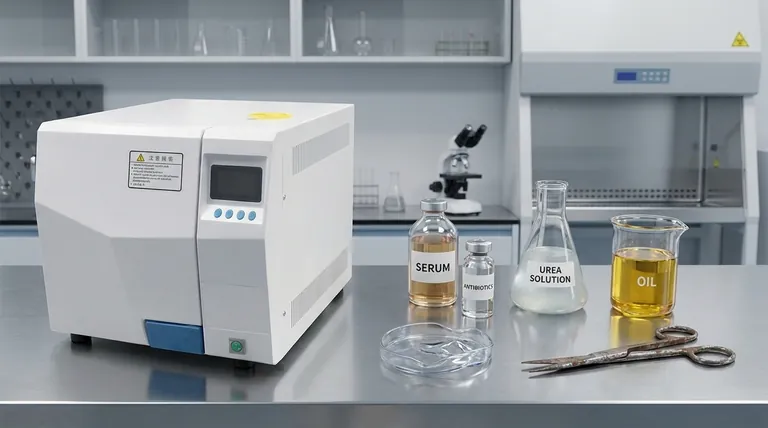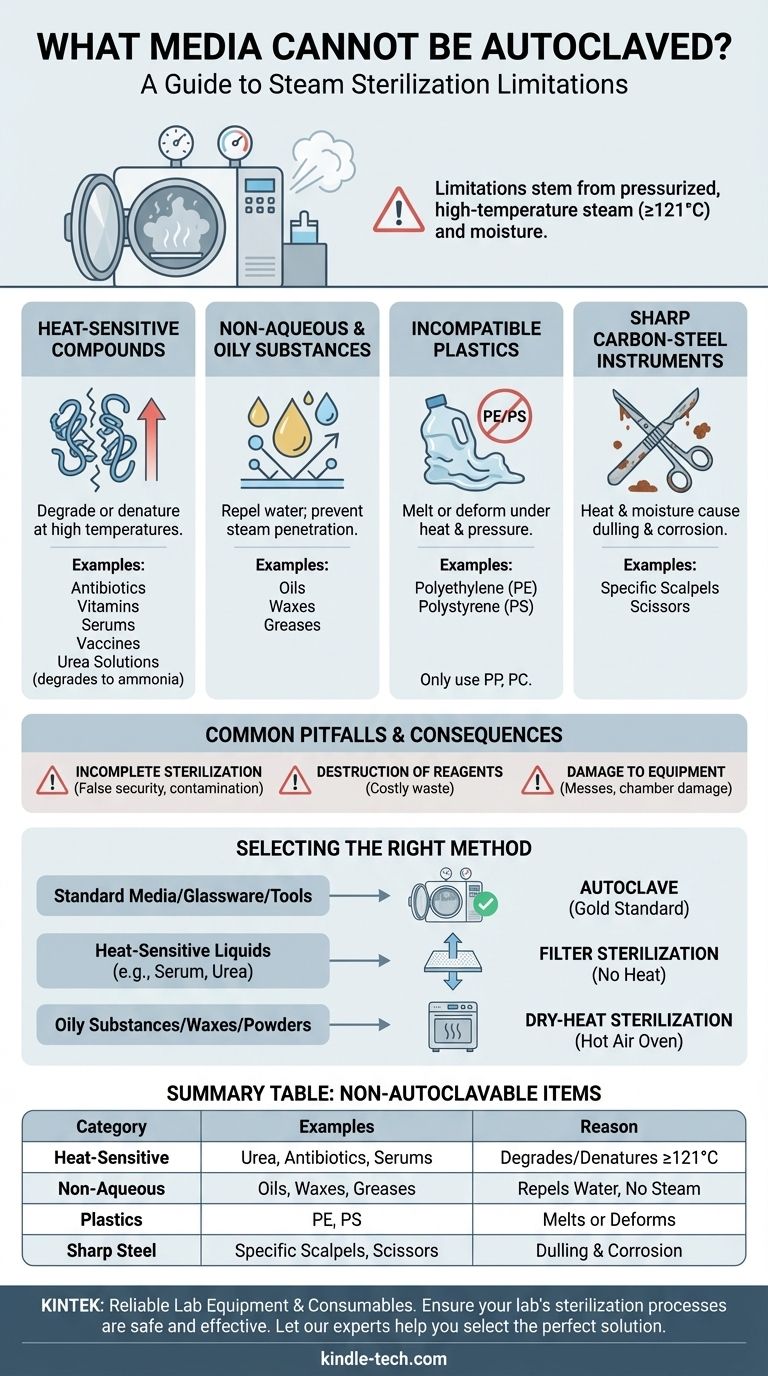In short, you cannot autoclave any media or material that is heat-sensitive, non-aqueous, or physically incompatible with high temperatures and pressure. This includes solutions containing certain proteins, antibiotics, and vitamins, as well as oils, some plastics, and sharp carbon-steel instruments.
The limitations of an autoclave stem from its core mechanism: pressurized, high-temperature steam. Any material that chemically degrades under intense heat, repels the water in steam, or will physically melt or deform is fundamentally incompatible with this sterilization method.

Why Steam Sterilization Fails for Certain Media
An autoclave uses superheated steam under pressure to destroy microorganisms. This process is incredibly effective, but its reliance on heat and water creates specific limitations. Understanding these principles is key to avoiding failed experiments and damaged materials.
Heat-Sensitive (Thermolabile) Compounds
Many biological reagents are destroyed by the high temperatures (typically 121°C or higher) inside an autoclave.
Excessive heat denatures proteins and breaks down complex molecules, rendering them useless. This is why you must never autoclave solutions containing temperature-sensitive antibiotics, vitamins, serums, or vaccines.
A common example is media containing urea, which degrades into ammonia and carbon dioxide under high heat, drastically altering the pH and composition of the medium.
Non-Aqueous and Oily Substances
Steam sterilization is fundamentally a water-based process. The moist heat must directly contact all surfaces to be effective.
Oily or waxy substances repel water, preventing the steam from penetrating and sterilizing them. Attempting to autoclave oils will result in incomplete sterilization, as microbes can survive within the non-aqueous substance.
Materials that Melt or Deform
While not a "medium," it's critical to know which containers are unsafe. Many common plastics cannot withstand the heat and pressure inside an autoclave.
Plastics like polyethylene (PE) and polystyrene (PS) will melt, potentially damaging your equipment and contaminating your load. Only plastics rated for autoclaving, such as polypropylene (PP) and polycarbonate (PC), should be used.
Sharp-Edged Instruments
While many surgical tools are autoclaved, high-grade carbon steel instruments like specific scalpels or scissors should not be.
The combination of extreme heat and moisture can cause these sharp edges to dull and corrode, compromising their function.
Common Pitfalls and Consequences
Making a mistake about what can be autoclaved leads to more than just inconvenience. The consequences can be costly and compromise the integrity of your work.
Incomplete Sterilization
This is the most dangerous outcome. Autoclaving an oily substance or a tightly-sealed container gives a false sense of security.
The material will have gone through the cycle, but it will not be sterile, creating a major risk of contamination for subsequent experiments.
Destruction of Expensive Reagents
Many heat-sensitive additives, like specific growth factors or antibiotics, are the most expensive components of a culture medium.
Autoclaving them is a simple but costly mistake, effectively pouring valuable resources down the drain.
Damage to Equipment
Melting a non-autoclavable plastic container can create a difficult mess to clean and may even damage the autoclave's chamber or drainage systems.
Always verify that any plasticware is explicitly marked as "autoclavable" or with the appropriate temperature and pressure ratings.
Making the Right Choice for Your Goal
Selecting the correct sterilization method is essential for success. Your decision should be based entirely on the composition of the material you need to sterilize.
- If your primary focus is standard microbiological media, glassware, or surgical tools: The autoclave is the gold standard for its reliability and effectiveness.
- If your primary focus is heat-sensitive liquids (e.g., serum, antibiotics, urea solutions): Use sterile filter sterilization to remove microbes without using heat.
- If your primary focus is oily substances, waxes, or moisture-sensitive powders: Use dry-heat sterilization, which sterilizes with hot air in an oven over a longer period.
Understanding your material's properties is the foundation of safe and effective sterilization.
Summary Table:
| Category | Examples of Non-Autoclavable Items | Reason |
|---|---|---|
| Heat-Sensitive Compounds | Urea solutions, certain antibiotics, vitamins, serums, vaccines | Degrades or denatures at high temperatures (≥121°C) |
| Non-Aqueous & Oily Substances | Oils, waxes, greases | Repels water, preventing steam penetration and sterilization |
| Incompatible Plastics | Polyethylene (PE), polystyrene (PS) | Melts or deforms under heat and pressure |
| Sharp Carbon-Steel Instruments | Specific scalpels, scissors | Causes dulling and corrosion from heat and moisture |
Ensure your lab's sterilization processes are safe and effective. Choosing the right method is critical for protecting valuable reagents and maintaining experimental integrity. At KINTEK, we specialize in providing reliable lab equipment and consumables tailored to your sterilization needs—whether you require autoclaves, filtration systems, or dry-heat ovens.
Let our experts help you select the perfect solution. Contact us today to discuss how KINTEK can support your laboratory's unique requirements and enhance your workflow efficiency.
Visual Guide

Related Products
- Desktop Fast Laboratory Autoclave Sterilizer 20L 24L for Lab Use
- Laboratory Sterilizer Lab Autoclave Pulsating Vacuum Desktop Steam Sterilizer
- Laboratory High Pressure Steam Sterilizer Vertical Autoclave for Lab Department
- Desktop Fast Laboratory Autoclave Sterilizer 35L 50L 90L for Lab Use
- Portable Digital Display Automatic Laboratory Sterilizer Lab Autoclave for Sterilization Pressure
People Also Ask
- What are the specifications of a laboratory autoclave? A Guide to Key Features for Safe Sterilization
- Can autoclave sterilize liquid? Master Safe and Effective Liquid Sterilization
- Is autoclave the same as sterilization? Unlocking the Key Differences for Lab Safety
- What lab supplies should be autoclaved? A Guide to Safe Sterilization and Decontamination
- What is an autoclave laboratory equipment? The Ultimate Guide to Steam Sterilization



















